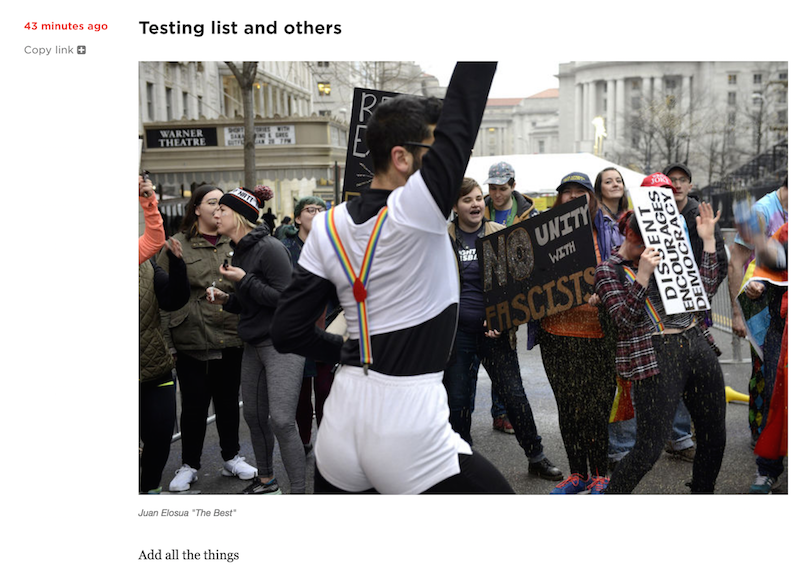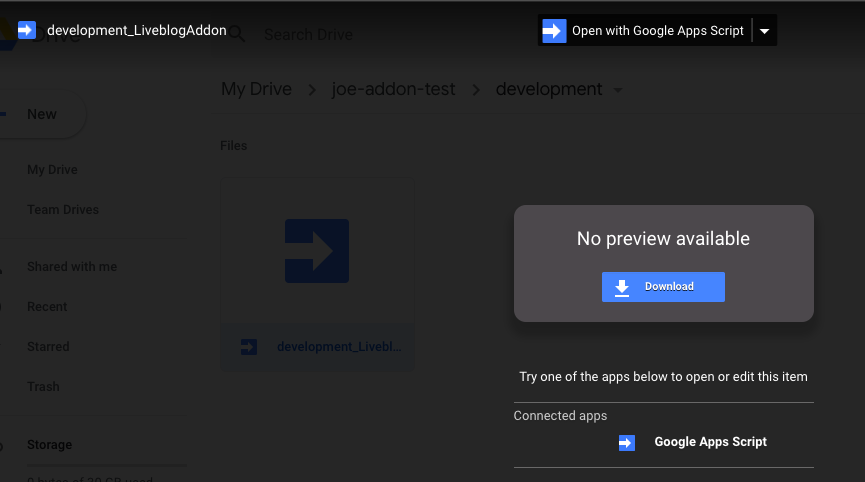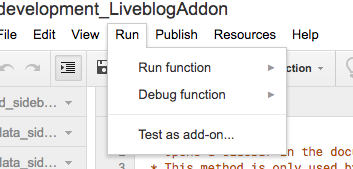- What is this?
- Assumptions
- What's in here?
- Hide project secrets
- Run the project
- Google Apps Scripts development
- Google Document Permissions
- License and credits
Google Docs Add-on to add liveblog posts.
If you just want to use it there's a publicly available Google Doc Template that you can make a copy of and it will include all the necesary code to run the Add-on.
The Add-on has these functions you can run:
- Initialize Document (required): Creates the pinned post at the top and adds an end marker to the document a couple of pages down.
- Set Authors Spreadsheet (required): Used to add an external accesible spreadsheet that will contain the metadata for all possible authors of the posts. It requires a certain schema. You can find an example here.
- Set Image Url Prefix (required): The root url where photos and graphics will be hosted
- Set Sidebar Logo (optional): Used to add a logo to the posts sidebar
- Add Post: Used to insert posts inside the liveblog
- Add Embed Shortcode: Used to insert media shortcodes into a given post
- Add AP Live Video: Used to insert an AP live videostream embed read about this
Each post consists of:
- start marker: Marks the start of a given post
- end marker: Marks the end of a given post
- metadata: Metadata for a given post including author information and a slug
- placeholder: Placeholder for the post text.
Even though it can be used for other purposes it was developed to be combined with NPR liveblog system. You can find more information of how to use that rig here.
Here's a screenshot of a post as displayed by our liveblog rig.
The source of the Liveblog Add-on is inside the code folder, the rest of the repo contains development tools that will allow us to upload the google app script project using our own oAuth credentials.
The following things are assumed to be true in this documentation.
- You are running OSX.
- You are using Python 2.7. (Probably the version that came OSX.)
- You have virtualenv and virtualenvwrapper installed and working.
- You have NPR's AWS credentials stored as environment variables locally.
For more details on the technology stack used with the app-template, see our development environment blog post.
The project contains the following folders and important files:
code-- Google Apps Script Add-On source filesfabfile-- Fabric commands for automating setup, deployment, data processing, etc.templates-- HTML (Jinja2) templates, to be compiled locally.app.py-- A Flask app for rendering the project locally.app_config.py-- Global project configuration for scripts, deployment, etc.render_utils.py-- Code supporting template rendering.requirements.txt-- Python requirements.
cd liveblog-addon
mkvirtualenv liveblog-addon
pip install -r requirements.txt
Problems installing requirements? You may need to run the pip command as ARCHFLAGS=-Wno-error=unused-command-line-argument-hard-error-in-future pip install -r requirements.txt to work around an issue with OSX.
Project secrets should never be stored in app_config.py or anywhere else in the repository. They will be leaked to the client if you do. Instead, always store passwords, keys, etc. in environment variables and document that they are needed here in the README.
Any environment variable that starts with $PROJECT_SLUG_ will be automatically loaded when app_config.get_secrets() is called.
A flask app is used to run the project locally. It will automatically recompile templates and assets on demand.
if [ ! -d "logs" ]; then mkdir logs; fi
workon liveblog-addon
fab app
Visit localhost:8000 in your browser.
We use our codebase stored on github as the master for the Google Apps Scripts code. We have created a series of Fabric commands to ease the workflow of updating the actual code run inside google drive.
fab gs.list_projects
It will return a complete list of Google Apps Script projects. It accepts and optional owner parameter to filter out the results to a given owner. for example the following command will return only the projects that you have created:
fab gs.list_projects:me
If you want to create the project on your own drive, first inside app_config.py update DRIVE_PARENT_FOLDER_ID to reflect one existing folder where you want the standalone script to live in. Then you can run:
fab [ENVIRONMENT] gs.create
This will create a new google apps script project on a subfolder that will depend on the ÈNVIRONMENT used development or production.
Imagine your root folder on drive is called scripts. The fabric tasks expect the following folder structure:
scripts
| development
| production
After you run gs.create, the script will be added to the ENVIRONMENT folder specified. Go to that folder and open the file with Google Apps Script (that should be one of the options, see screenshot below).
## Test as an Add-On
While you are making changes to the google apps script, we strongly recommend that you use the Run -> Test as add-on option on the project until you are happy with the results.
## Upsert project
If you want to update local changes to a Google Apps Script Project you can run:
fab [ENVIRONMENT] gs.upsert
Where ENVIRONMENT can be: development or production. Depending on the environment passed the command will update the appropriate Google App Script Project using app_config properties. For development it would be:
fab development gs.upsert
Once your code has been added to the Google Drive, there is a manual process to add it to an existing Google Doc. This is because the deploy as add-on functionality requires a complex permissions set-up.
This is the process:
- In the Google Doc go to the Tools --> Script Editor menu option.
- This will open a Google Scripts edit interface. Make sure you have another Google Scripts tab open to the new code.
- Figure out which files have changed and copy and paste from the new code to the old code. In the case of updating the shortcode sidebar, that meant updating embed.gs, embed_sidebar.html and embed_sidebar_js.html.
- Refresh the Google Doc (which will close that doc's Google Script tab), and see if the new code works.
We are accessing the Live Fact Check document from the server to pull out its content using credentials associated with nprappstumblr@gmail.com we need to make sure that nprappstumblr@gmail.com has at least read access to the document in order to avoid a 403 response to the server.
Released under the MIT open source license. See LICENSE for details.
This repo was developed by NPR Visuals team.
See additional CONTRIBUTORS



